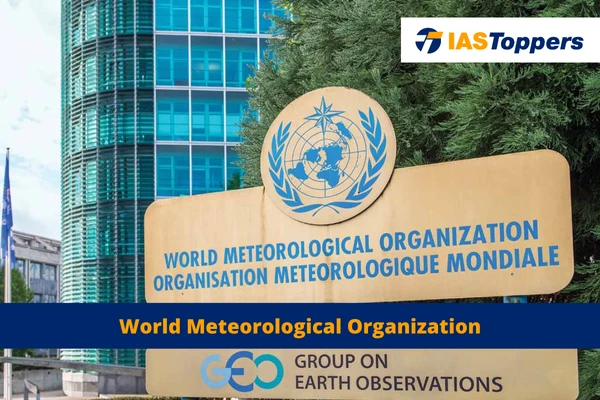World Meteorological Organization is a specialized agency of the United Nations that promotes international cooperation in atmospheric science, climatology, hydrology, and geophysics. In this article, you will get information about World Meteorological Organization, its definition, objectives, functions, governance, etc.
This article will provide key insights for GS Paper- III Environment and ecology section of UPSC IAS Exam.
Table of Content
- What is World Meteorological Organization?
- Formation of World Meteorological Organization
- Background of World Meteorological Organization
- Member states of WMO
- Functions of World Meteorological Organization
- Governance of WMO
- WMO Strategic Plan and formation of important organisations
- Important reports by WMO
- Conclusion
- Frequently Asked Questions
- Reference
What is World Meteorological Organization?
- The World Meteorological Organization (WMO) is a specialized agency of the United Nations that promotes international cooperation in atmospheric science, climatology, hydrology, and geophysics.
Formation of World Meteorological Organization:
- The WMO had originated in March 1950 from the International Meteorological Organization (IMO).
- International Meteorological Organizationwasa non-governmental organization established in 1873 to facilitate the exchange of weather data and research.
- Efforts to revamp the status and structure of the IMO has led to the formation of the World Meteorological Organization through the World Meteorological Convention of 1947.
- The World Meteorological Organization Convention was signed on 11 October 1947, and later ratified on 23 March 1950.
- This convention has officially established the WMO as an intergovernmental organization within the UN system and outlines the objectives, governance, and overall structure of WMO.
Background of World Meteorological Organization:
- 193 countries and territories are its members.
- Countries are grouped in 6 different regions.
- Its headquarters is located in Geneva, Switzerland.
- The WMO is governed by the World Meteorological Congress, which is convened every fouryears to determine policies and priorities.
- The Congress is led by an Executive Council headed by the President.
- The World Meteorological Day is held annually on 23 March.
Member states of WMO:
- Region I consists of the states of Africa and a few former colonial states.
- Region I has 57 member states.
- Region II has 33 member states and 2 member territories lying in the Asia.
- Region III consists of the states of South America, including France as French Guiana is an overseas region of France.
- Region III has a total of 13 member states and no member territories.
- Region IV consists of the states of North America, Central America, and the Caribbean, including three European states with dependencies within the region.
- Region IV has a total of 25 member states and 2 member territories.
- Region V consists of 23 member states and 2 member territories surrounding the continent of Australia.
- Region VI consists consist of all the states in Europe and some Western Asia.
- It has 50 member states.
Functions of World Meteorological Organization
- The WMO enables the “free and unrestricted” exchange of data, information, and research among the meteorological and hydrological institutions of its member states.
- The WMO collaborates with non-governmental partners and international organizations on various environmental protection, climate change, resource management, and socioeconomic development initiatives.
- The WMO promotes standardized meteorological observations by providing various code formats for representing and sharing meteorological, oceanographic, and hydrological data.
- The WMO develops a list of names that are assigned in alphabetical order to tropical storms.
Governance of WMO:
- The WMO operates under a hierarchical framework consisting of the following components:
- The World Meteorological Congress is the highest authority within the organization that determines its policies.
- The congress meets every four years where each member state and territory appoint a Permanent Representative to represent them.
- The congress elects the President, vice-presidents, members of the Executive Council, and appoints the Secretary-General.
- The Executive Council implements the decisions made by the World Meteorological Congress.
- The Secretariat of WMO is comprised of eight departments and is headed by a Secretary–General.
WMO Strategic Plan and formation of important organisations:
- Disaster risk reduction
- The Global Framework for Climate Services (GFCS)
- World Climate Research Programme
- The WMO Integrated Global Observing System (WIGOS)
- Aviation meteorological services
- Intergovernmental Panel on Climate Change (IPCC)
- Formed in partnership with the United Nations Environment Programme (UNEP).
Important reports by WMO:
- WMO releases an annualreport– the WMO Statement, which provides information on the global, regional, national temperatures, and extreme weather events.
- It includes data on long-term climate change indicators such as greenhouse gas concentrations, sea level rise, and sea ice extent.
- State of the Global Climate report
Conclusion
As a specialized agency of the United Nations, the WMO plays a pivotal role in promoting global cooperation and collaboration in understanding and addressing weather and climate-related challenges. Through its collaborative efforts, the WMO continues to provide invaluable services, empowering nations to mitigate risks, build resilience, and navigate the complex challenges of a changing climate. It plays a key role in coordinating emergency response efforts during natural disasters, helping to mitigate their impacts and protect lives and property.
Ref: Source-1
| Other Articles in Environment & Disaster Management | |
| Disaster Management in India | Glacial Lake Outburst Flood |
| Urban Flooding | Geomagnetic Storms |
| National Green Tribunal | Smog |
FAQs (Frequently Asked Questions)
Define World Meteorological Organization.
The World Meteorological Organization (WMO) is a specialized agency of the United Nations that promotes international cooperation in atmospheric science, climatology, hydrology, and geophysics.
What does the World Meteorological Organization do?
The WMO enables the “free and unrestricted” exchange of data, information, and research among the meteorological and hydrological institutions of its member states.
How many countries or members does World Meteorological Organization have?
193 countries and territories are members of WMO.




